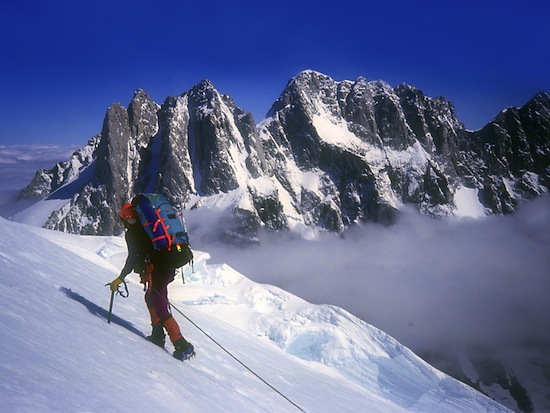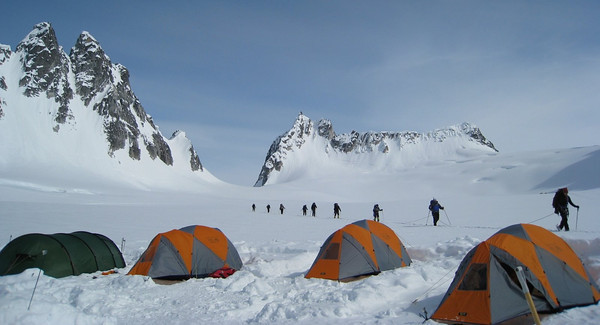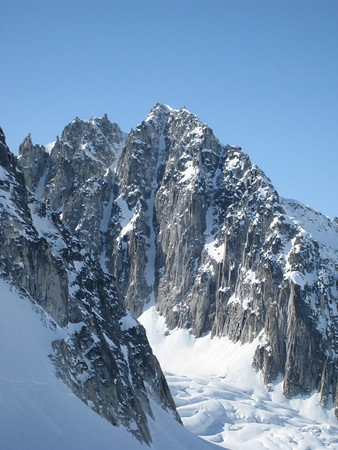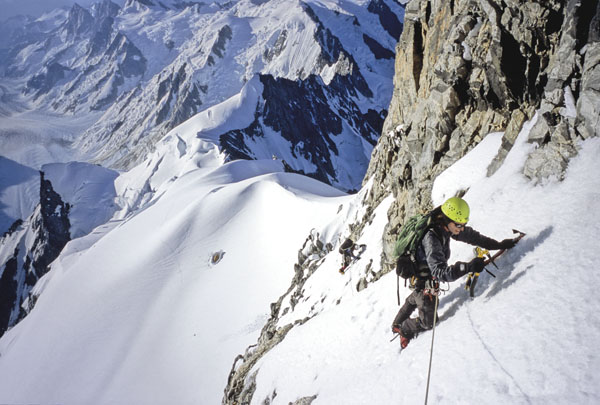Alpine Mountaineering and Technical Leadership, Part 4 Overview AAI's four-part mountain leadership program has been called "the country's most respected and thorough rock and mountaineering course," by Men's Journal. It consists of four 12-day segments, and you can choose to take one, two, three, or all four. Part 1 provides a comprehensive introduction to all the skills of alpine mountaineering, general team leadership, and leading rope teams on glaciers. Part 2 develops techniques for leading multi-pitch rock routes while further advancing technical and evaluative skills on snow, ice, and rock. Part 3 allows you to continue to develop your technical leadership skills while providing an opportunity to focus those skills on one of three areas. Part 4 is an expedition in which all of the skills developed are employed in a remote and complex big mountain setting.
Part 4 - Remote Expedition The final portion of the program offers participants the opportunity to take part in an expedition to one of three places, the Ptarmigan Traverse in the Cascades, a backcountry ski adventure during winter, or the Bravo Glacier on Canada's Mount Waddington.
Climbers return to base camp on an AMTL 4 Course.
The Ptarmigan Traverse traces the line pioneered by the Ptarmigan Climbing Club in 1938. The original traverse included ascents of many summits, including Mixup Peak, Mount Formidable, and Dome Peak. Participants may attempt these peaks, and/or other classic and remote mountains along the route like Magic Mountain, LeConte Peak, Sentinel Peak, Old Guard, Sinister Peak, Gunsight Peak and Dome Peak
The Cascade backcountry in the winter is as remote as either of the other objectives. Areas that are teeming with people in the summer are incredibly remote in the winter. This third option for AMTL 4 provides climbers with a completely new set of skills. They will learn ski mountaineering, avalanche and winter expeditionary skills that they will use to access some of the most secluded terrain in the Lower 48.
Mount Waddington, at 13,177 feet (4017 m.) is the highest mountain in British Columbia. The first ascent of the Northwest (false) summit was in 1934, however most modern parties approach from the south or east now to reach the true summit. The Main Summit was claimed by Fritz Weissner and William House in 1936. In 1942 Mount Waddington was climbed by then-teenagers, Fred and Helmy Beckey, whose footwear consisted of "felt pullovers on tennis shoes."
Students who complete all four parts of the AMTL series will receive a certificate of Alpine Mountaineering and Technical Expedition Leadership. Students may also elect to take a second version of Part 3 as a substitution for these Part 4 options to receive this certificate.
In order to participate in this high-end expedition, you must first complete Parts 1, 2, and 3. If you took Part 3 more than a year-and-a-half prior, you will need to take a four-day refresher course. If you have engaged in a significant amount of climbing in the interim this may be waived.
Alpine Mountaineering and Technical Leadership, Part 4 Curriculum Alpine Mountaineering Skills:
Development of mixed climbing skills - participants will transition from snow climbing to rock climbing on most routes.
Continued development of movement skills on moderate ice and technical rock
Development of simul-climbing skills on lower angled ice with running belays
Study and practice of transitions between glacier travel mode and technical climbing mode
Continued study of the proper choice between and application of the primary ice axe Positions: piolet canne, panne, manche, poignard, ramasse, rampe, ancre, and traction
Specialized designs and uses of alpine and technical tools in high angle climbing
Free climbing technique on alpine rock
Advanced concepts in the proper selection and placement of snow, ice and rock gear for belays and intermediate protection
Integration of specific skills with the general goals of efficient, safe, and self-dependent climbing
Expeditionary Skills:
Continued training on the use of maps, compasses, GPS, and guidebooks
Strategizing for multi-day backcountry tours in a remote setting
Practical application of expeditionary staged camp techniques
Mountaineering Skills:
Review of glacial and ice structures
Continued development of mountain sense and the ability to follow a "line of weakness"
Development of advanced technical protective systems in an alpine setting
Advanced study of movement over complex alpine terrain
Objective Hazards Evaluation & Self-Rescue Skills:
Evaluation & prediction of mountain weather patterns
Introduction to the assessment of natural hazards
Individual & team crevasse rescue techniques
Individual & team high angle rescue techniques
Leadership Skills:
Continued study and practice of individual technical leadership skills
Development of technical leadership strategies on complex terrain
Technical & personal functions of individuals on an ascent: roles & responsibility
Problem solving: gathering appropriate data & assessment techniques
Evolving leadership roles: individual leadership vs. collective decision making
Large and small team expeditionary leadership strategy
Ski Mountaineering Skills (for those who choose the ski option)
selection and use of personal equipment for ski mountaineering
snowpack study of snowpack formation, metamorphosis, and stability assessment
cross-country and downhill skiing skills; methods of ascent and descent
adjustment in technique for challenging snow conditions
route selection and hazard assessment
roped skiing and travel skills
constructing snow anchors with ski equipment and operating belays
basic skills for the use of ski crampons
Leave No Trace travel, climbing and camping skills
use of electronic transceivers; avalanche rescue procedures
Alpine Mountaineering and Technical Leadership, Part 4 Course Options Ptarmigan Traverse Structure and Goals:
In this fourth 12-day segment of the program you will develop more sophisticated technical skills on rock, snow and ice while making an expedition style traverse on a high route through the Cascades. The Ptarmigan Traverse is a classic route between dozens of peaks. The opportunity to climb something remote will present itself on almost every day of the program.
Students will continue to refine their alpine climbing, navigation and trip planning skills, while also managing the burden of a long and remote trip without a basecamp to rely on.
This will not be a guided program. The students will be running this trip. The instructors will be there to provide feedback and instruction when there are questions. But the students should complete this program with a strong understanding of how to go about building an expedition on their own.
Ski Mountaineering and Remote Alpine Ski Tour
Structure and Goals:
In this fourth 12-day segment of the program you will develop more sophisticated skills on glaciers and on steep snow. Additionally, participants will develop the skills to move effectively on both glaciated and non-glaciated terrain on backcountry skis. The course will culminate in a multi-day backcountry ski tour or high traverse.
A skier is rewarded for their climb with an exciting descent.
All participants will learn the skills specific to crevasse rescue with skis, they will learn about the care and maintenance of backcountry skis, they will learn the rudiments of snow science and avalanche evaluation and they will develop the skills to plan both single and multi-day peak descents.
This particular course has additional prerequisites beyond Parts 1-3. Skiers who participate in this course should be comfortable on moderate to steep terrain when skiing inside of a ski resort. At minimum, skiers should be comfortable on tricky blue runs or easy black runs. This course was designed for competent in-bounds skiers who are ready to move into the backcountry.
Your instructors will work with you on all of the specific skills needed for route selection, route finding, and hazard evaluation required for ski mountaineers. It is our goal that you emerge from this program as a qualified rope team leader and a qualified skier in technical backcountry travel.
Mt. Waddington Expedition Structure and Goals:
A climber on the approach to basecamp on Mt. Waddington with the expansive Coast Mountains in the background. AAI Collection
In this fourth 12-day segment of the program you will develop more sophisticated technical skills on rock, snow and ice while making an expedition style ascent of Mount Waddington. This is one of the rare courses in the world that finishes on such a remote, technical and beautiful mountains.
Mount Waddington is a very serious objective. This expedition will draw deeply on all of your skills. Climbers must be able to move effectively on glaciers, rock climb, ice climb and ascend mixed terrain to be successful on this mountain. A successful ascent of Mount Waddington is the equivalent of a PhD in Alpinism. It is a remote and highly sought after objective.
During this expedition, your instructors will continue to help you to refine expeditionary skills and techniques. With guidance, you will plan every part of this expedition and will be a co-leader in the decisions that will be made. It is our goal that you emerge from this program as a qualified rope team leader on both rock and glacier routes. It is also our goal that upon completion, you have the skills and the understanding to put together an expedition to one of the greater ranges of the world.
UPDATE - This program is no longer available without a commitment 18-months ahead of time and a $2,000 non-refundable deposit. The price for this program is wildly variable due to flight costs and limited space in the helicpopter. Rates for this program range from $7,500-$10,000. Call for details.
Alpine Mountaineering and Technical Leadership, Part 4 Dates & Details 4a Ptarmigan Traverse Expedition
July 14 - July 25, 2024
Aug 04 - Aug 15, 2024
Aug 25 - Sept 05, 2024
Max Ratio - 2:1 (Climber:Guide)
Capacity - 8 (based on instructor availability)
Food will be provided, but shopping will be done as a team as part of the expedition prep.
4b Waddington Expedition ($4450)
Max Ratio - 4:2 (Climber:Guide)
Capacity - 5
Food will be provided, but shopping will be done as a team as part of the expedition prep.
4c Ski Mountaineering Expedition ($4450)
Max Ratio - 2:1 (Skier:Guide)
Capacity - 6
Food is NOT included in this option. However, lodging during the front-country portions of the trip are included.
PLEASE NOTE
If you are looking to use GI Bill® Benefits to pay for your courses, they can be used only on the Ski Mountaineering and the Ptarmigan Traverse expeditions. GI Bill® benefits can not be applied to the Mt. Waddington Expedition.
Prerequisites
Part 4a
AMTL Part 1, Part 2, and Part 3 or equivalent experience
Confidently and smoothly lead 5.7 traditional rock.
Lead alpine rock climbs in mountain boots and/or crampons.
Apply appropriate aid and bigwall techniques.
Lead steep, technical snow.
Lead 50+ degree ice.
Confidently lead a rope team in complex glaciated terrain.
To participate in the ski mountaineering option, skiers must have successfully completed a AIARE Level I Avalanche Course or the equivalent.
Alpine Mountaineering and Technical Leadership, Part 4 Testimonials
Men's Journal calls this program "the country's
most respected and thorough rock and mountaineering
course."
"The 4-part course was just what we were looking
for: a systematic way to learn how to lead on rock and glaciers,
starting from minimal experience on those media. By going through
the course, we now have a whole new dimension to explore on our
backcountry trips."Myron and Adele (Laramie, WY)
Mt. Waddington is among the most remote, beautiful, and seldom seen
climbs in N. America. Dylan Taylor
Alpine Mountaineering and Technical Leadership, Part 4 Related Courses
Program Finder
By Location
United States - Alaska
United States - Washington
United States - California
United States - Nevada
United States - Colorado
United States - Utah
Canada - British Columbia
South America - Argentina
South America - Bolivia
South America - Ecuador
South America - Patagonia
South America - Peru
Europe - Alps and Caucasus
Asia - Nepal and Tibet
Asia - Laos, Thailand, & Vietnam
Asia - China
Asia - Japan
Africa - Tanzania
Pacific and Antarctica
By Program Type
Instructional Courses
Group Summit Climbs
Expeditions
Skills Expeditions
Private Guided Programs
Treks, Tours, & Backpacking
Corporate Outings & Services
Government & Military
By Activity
Rock Climbing
Ice Climbing
Alpine Climbing
High-Altitude Climbing
Trekking and Backpacking
Skiing & Snowboarding
Guide Training & Rescue
Avalanche Training
Departure Month
Difficulty Level
Beginner
Moderate
Intermediate
Advanced
Very Advanced
x



